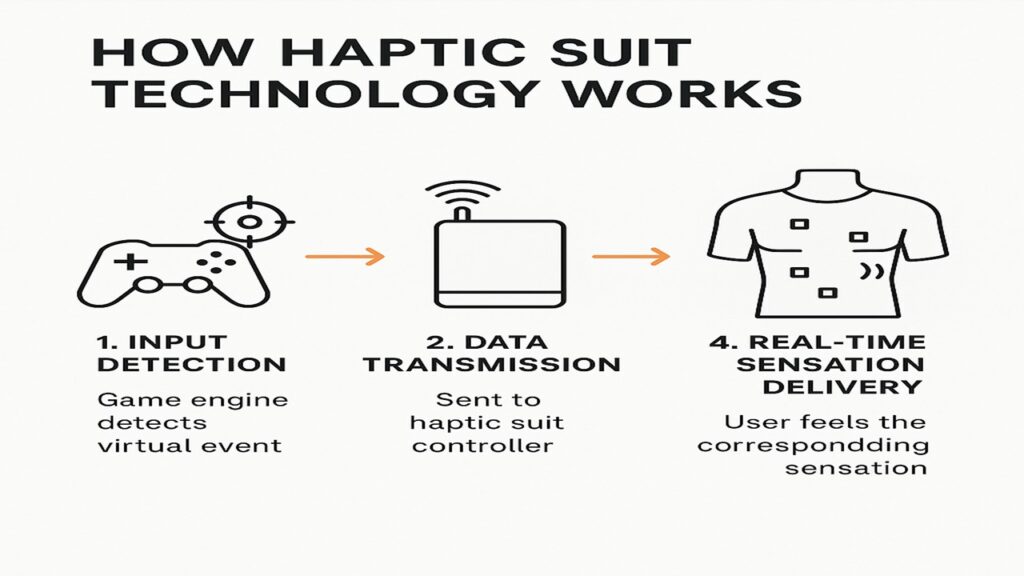
Imagine you’re playing a video game — the enemy shoots you, and you actually feel a jolt on your chest. A gust of wind blows through a virtual forest, and you sense a chill down your spine. Someone taps your shoulder in the game — and you feel it in real life.
Sounds like sci-fi? Not anymore.
Thanks to a groundbreaking technology called the Haptic Suit, the world of virtual gaming is breaking through the screen and entering your senses.
🤖 What is a Haptic Suit?
A Haptic Suit is a wearable full-body suit embedded with sensors, motors, and actuators that simulate touch, pressure, vibrations, heat, or cold sensations on your body — just like in real life.
It is mainly used in Virtual Reality (VR) and Augmented Reality (AR) environments to let the user not just see, but actually feel what’s happening in the game or simulation.
⚙️ How Does This Technology Work? – Step-by-Step Process

- Input Detection
The game engine detects a virtual event (e.g., gunshot, punch, wind, etc.). - Data Transmission
This data is transmitted wirelessly or via cable to the haptic suit controller. - Activation of Sensors & Actuators
Based on the event, the suit activates the appropriate motors or haptic feedback modules. - Real-Time Sensation Delivery
The user feels the exact sensation at the exact body part where the virtual interaction happened.
🌍 Who is Researching & Building Haptic Suits?
Here are some leading companies and countries working on haptic suit technology:
- Teslasuit (UK) – Advanced full-body suits used in gaming, healthcare, and sports training.
- bHaptics (South Korea) – Their TactSuit series is widely used in VR gaming.
- Sony (Japan) – Working on haptic features for future PlayStation VR experiences.
- Meta (USA) – Developing haptic gloves and suits for the Metaverse.
- AxonVR (USA) – Focused on hyper-realistic full-body feedback systems.
- India – IITs and emerging startups are researching haptics, particularly in defense and healthcare applications.
Future Benefits of Haptic Technology
- Hyper-realistic gaming experience
- Safer medical training (simulated surgeries)
- Military simulations with real-time feedback
- Aviation and astronaut training
- Human interaction in the Metaverse (handshakes, hugs, etc.)
- Accessibility for the visually impaired through touch-based feedback
⚠️ Challenges Ahead
- High cost (₹2 to ₹10 lakh or more)
- Bulkiness and comfort issues
- Battery limitations and latency
- Still under development for mass adoption
- Limited availability in developing countries
When Will This Reach the Public?
By 2025–2027, we can expect more affordable versions of haptic suits in global markets.
In India, wider accessibility could happen by 2028, especially as gaming and Metaverse demand continues to grow.
🗣️ Virtual is About to Get Real
“What you once could only see, you’ll now be able to feel.”
The Haptic Suit isn’t just a new tech toy — it’s a revolutionary bridge between humans and machines. Whether in gaming, education, military, or medicine — haptics is redefining how we experience the digital world.
The future is almost here. And the next time you play Call of Duty… that bullet might actually sting.

































































